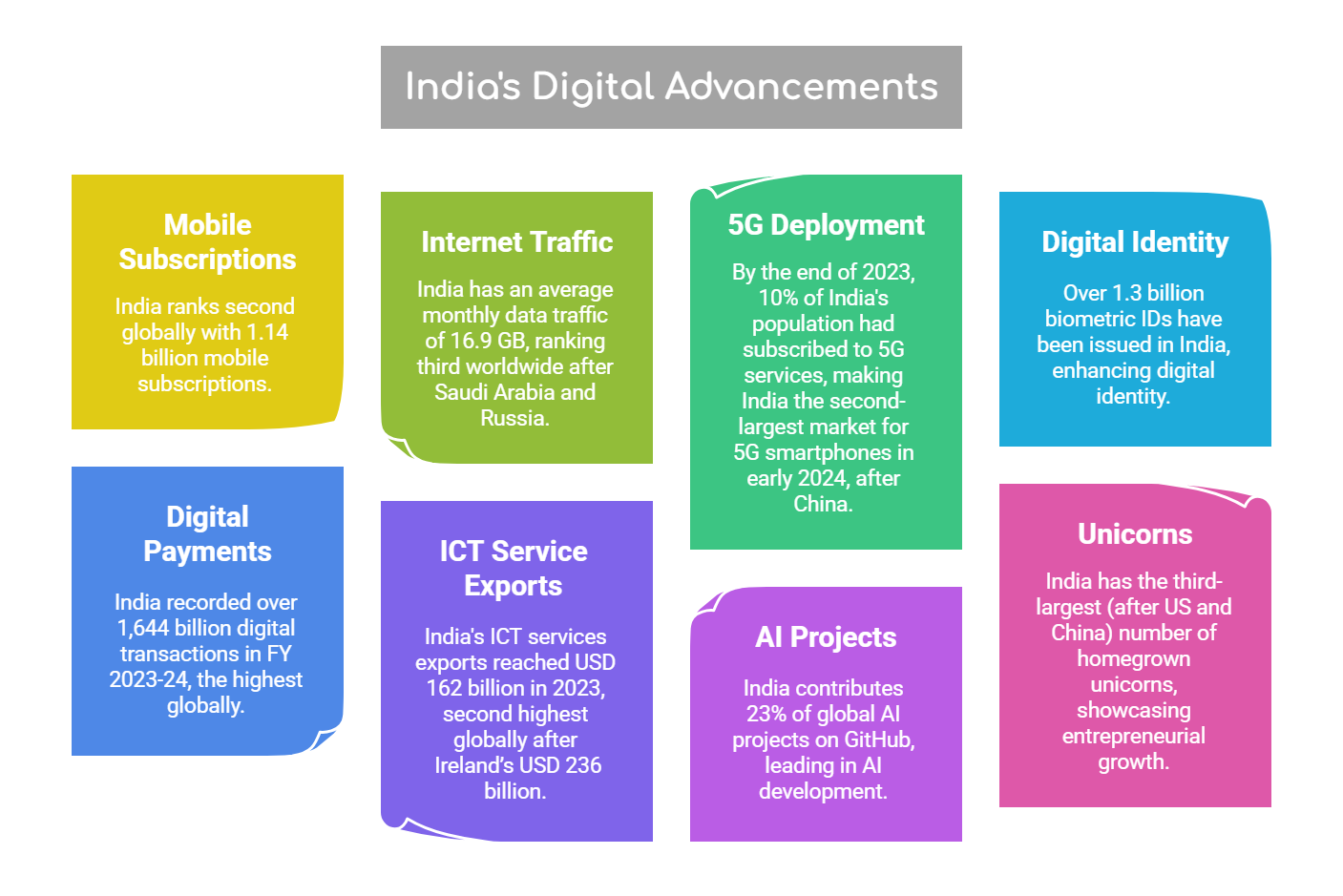Governance
State of India’s Digital Economy (SIDE) Report 2024
- 06 Feb 2025
- 6 min read
For Prelims: State of India’s Digital Economy (SIDE) Report 2024, Digital India, BharatNet , Open Network for Digital Commerce, 5G rollout, Skill India Digital Hub, India’s Atma Nirbhar Bharat vision, Ayushman Bharat Digital Mission.
For Mains: Key Drivers of India’s Digital Growth, Key Issues Associated with India’s Digital Growth.
Why in News?
The State of India’s Digital Economy (SIDE) Report 2024, published by the Indian Council for Research on International Economic Relations (ICRIER) and based on a study by the Ministry of Electronics and Information Technology (MeitY), provides a comprehensive analysis of India’s digital economy.
What are the Key Highlights of State of India’s Digital Economy Report 2024?
- India's Digital Economy Standing: India is the 3rd largest digitalized (behind the US and China) economy in the world in terms of economy-wide digitalisation.
- It ranks 12th among G20 nations in terms of digitalisation of individual users, indicating lower average user digitalisation.
- Contribution of Digital Economy: In 2022-23, the digital economy contributed 11.74% to GDP, with projections to rise to 13.42% by 2024-25.
- It employs 2.55% of the workforce with productivity 5 times higher than the overall economy.
- Future Projection: By 2029-30, the digital economy is expected to contribute one-fifth (20%) of GDP, surpassing agriculture and manufacturing.
- Sectoral Breakdown: The traditional ICT sector is the largest contributor to the digital economy, while new digital industries, including Big Tech and platforms, account for nearly 2% of GVA.
- State-Level Disparities: Richer states like Karnataka, Maharashtra, Telangana, Gujarat, and Haryana exhibit higher digitalisation levels compared to poorer states.
CHIPS (Connect-Harness-Innovate-Protect-Sustain):
- The CHIPS (Connect-Harness-Innovate-Protect-Sustain) framework, introduced in the SIDE 2024, offers a comprehensive approach to measuring digitalization, focusing on outcomes and risks.
- Unlike traditional indices that emphasize internet access, the CHIPS framework includes 5 pillars (Connect, Harness, Innovate, Protect, Sustain) and 50 indicators, enabling comparisons at both national and sub-national levels.
What are the Key Drivers of Digital Economy Growth in India?
- Expanding Digital Infrastructure: India’s digital infrastructure is bridging urban-rural divides and fueling a vibrant digital economy.
- Initiatives like BharatNet are providing high-speed internet to rural areas, while the 5G rollout is enhancing digital adoption, e-governance, e-commerce, fintech and IT services especially in underserved regions.
- Programs like Open Network for Digital Commerce (ONDC) are enabling small businesses to enter the digital marketplace.
- Rising Smartphone Penetration: Affordable smartphones and low-cost data have positioned India as a mobile-first economy, enhancing access to online education, digital payments, and entertainment.
- Domestic manufacturing incentives are supporting India's Atma Nirbhar Bharat initiative.
- Global Capability Centers (GCCs): India hosts 55% of the world’s GCCs, which provide essential services like IT support, R&D, and business process management.
- Start-Up Ecosystem and Innovation: India’s startup ecosystem is a major driver of digital innovation. Initiatives like Start-Up India and strong funding have helped tech startups address unique market needs.
- In 2024, Indian startups raised USD 30.4 billion in funding, despite global economic challenges.
- Digital Financial Inclusion: Programs such as UPI and Jan Dhan accounts are transforming financial inclusion in India, especially in rural areas.
- UPI processed Rs 23.49 lakh crores across 16.58 billion transactions in October 2024.
What are the Key Issues Associated with India’s Digital Growth?
Read more: Navigating India’s Digital Growth
What Steps can be taken to Strengthen and Secure the Digital Landscape in India?
Read more: Navigating India’s Digital Growth
Conclusion
India’s digital economy is a key driver of economic growth and employment. The digitalization of traditional sectors, along with the rise of digital platforms, is transforming industries and creating new job opportunities. With growing digital literacy, adoption of emerging technologies, and expanding employment prospects, India is well-positioned to lead in digital transformation, ensuring sustainable and inclusive growth.
UPSC Civil Services Examination Previous Year Question (PYQ)
Prelims
Q. Consider the following: (2022)
- Aarogya Setu
- CoWIN
- DigiLocker
- DIKSHA
Which of the above are built on top of open-source digital platforms?
(a) 1 and 2 only
(b) 2, 3 and 4 only
(c) 1, 3 and 4 only
(d) 1, 2, 3 and 4
Ans: (d)
Mains
Q. “The emergence of the Fourth Industrial Revolution (Digital Revolution) has initiated e-Governance as an integral part of government”. Discuss. (2020)

 _Framework.png)




